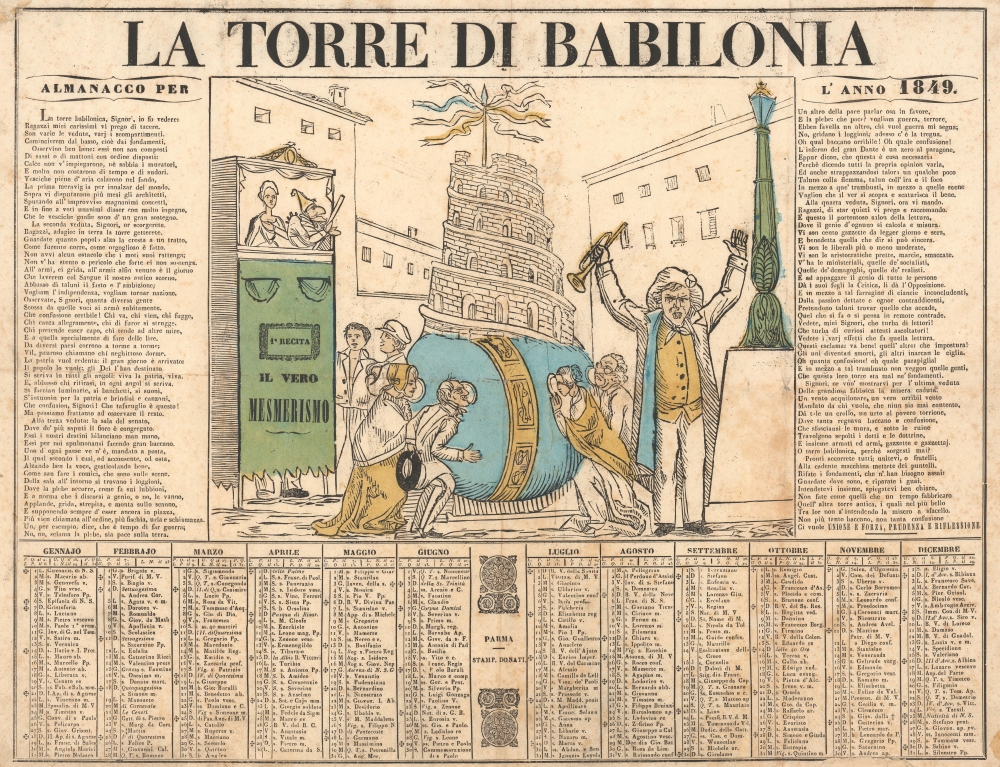1848 Italian Broadside Decrying the Revolutions of 1848
TorreBabilonia-unknown-1848$1,500.00

Title
La Torre di Babilonia. Almanacco per l'Anno 1849.
1848 (undated) 16.25 x 21 in (41.275 x 53.34 cm)
1848 (undated) 16.25 x 21 in (41.275 x 53.34 cm)
Description
This is a c. 1848 Italian satirical broadside decrying the chaos of the 1848 People's Revolutions in Italy. The evocative political propaganda piece combines a woodcut image, a poetic description of said image, and an almanac for 1849. It is an excellent example of 19th-century Italian political ephemera.
This 'Babel'-onian scattering of peoples and the lack of communication are here presented as metaphors for the 1848 Revolutions in Italy. Italy, at the time, was a disparate collection of duchies, principalities, and other states. Although revolutions and uprisings occurred throughout Italy, there was no coordination between groups, and demands were inconsistent and contradictory - a seeming cacophony of babbling 'hot air' to the ruling classes, here represented as well-dressed onlookers.
In the end, this condemns the chaos and bloodshed of the 1848 Revolutions. However, if the last lines are to be believed, it does not condemn the idea of the revolutions but how they were executed.
A Closer Look
The central image features the Tower of Babel rising on top of an inflated balloon. The ballon has portholes, open to reveal chaos inside. A well-dressed crowd has gathered around the balloon and the noticeably unsteady Tower while a performer holding a trumpet encourages others to see the spectacle. A puppet theater appears along the left border, and two people in the crowd seem to be listening to the performance.The Tower of Babel and the Revolutions of 1848 in Italy
The Tower of Babel is a Biblical reference to the Book of Genesis, wherein mankind, rather than disperse as intended by God, built a great tower in an attempt to reach heaven. Annoyed, God 'confuses the speech' of humanity, making them unable to understand one another and thus causing them to disseminate across the Earth.This 'Babel'-onian scattering of peoples and the lack of communication are here presented as metaphors for the 1848 Revolutions in Italy. Italy, at the time, was a disparate collection of duchies, principalities, and other states. Although revolutions and uprisings occurred throughout Italy, there was no coordination between groups, and demands were inconsistent and contradictory - a seeming cacophony of babbling 'hot air' to the ruling classes, here represented as well-dressed onlookers.
Using the Poem for Context Clues
The poem on either side of the central image states in the first stanza that the 'Babylonian tower' sits upon 'bladders filled with air.' This 'hot air' must be the revolutionary talk elevating the disorganized unity of the Italian states, represented by the Tower of Babel. Further on, a peace discussion occurs while the crowd yells, 'What peace? We want war, terror.' In the last part of the poem, the Tower collapses, but the narrator calls for supports and to 'rebuild the foundations' (which, remember, had been a 'bladder full of hot air'). The last line states, 'What is needed is UNION AND STRENGTH, PRUDENCE AND REFLECTION.'In the end, this condemns the chaos and bloodshed of the 1848 Revolutions. However, if the last lines are to be believed, it does not condemn the idea of the revolutions but how they were executed.
Revolutions of 1848 in Italy
The Revolutions of 1848 in Italy were part of a broader wave of European uprisings that sought to challenge conservative rule and promote liberal reforms, nationalism, and independence. In Italy, these revolutions aimed to end Austrian dominance in the north and unify the fragmented Italian states. Inspired by liberal ideas, the revolts erupted in cities like Milan, Venice, and Rome. Key figures such as Giuseppe Mazzini and King Charles Albert of Piedmont led efforts to establish constitutional governments and expel foreign powers. However, despite initial successes, the revolutions were ultimately crushed by Austrian forces, and conservative rule was restored. Though these uprisings failed, they ignited a stronger desire for Italian unification, laying the groundwork for the Risorgimento movement, which ultimately led to the unification of Italy in the 1860s.Publication History and Census
This broadside was created and published by an unknown author in Parma, Italy, c. 1848. This piece would have been posted on the street and handed out in bars, cafes, and similar establishments. Hence its ephemeral nature and extreme rarity. This is the only known surviving example.Condition
Good. Toning. Closed edge tears professionally repaired on verso. Infill to bottom right corner including part of the bottom border.

